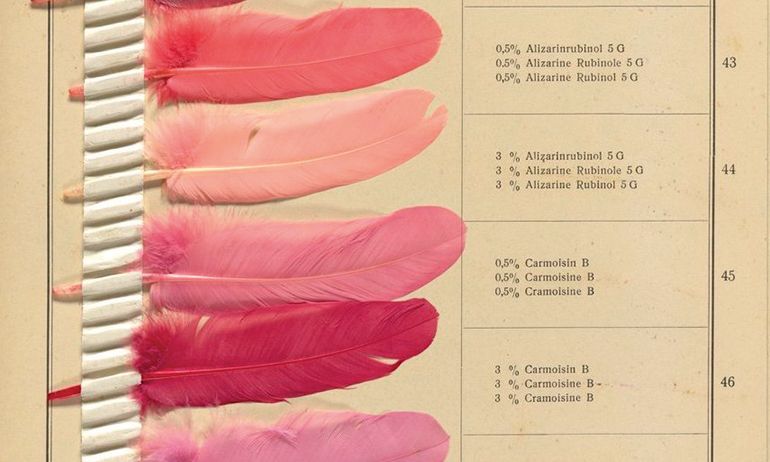An instructional dye sample book demonstrating shades on feathers Courtesy of Science History Institute
Artists and designers today have an assortment of colours at their fingertips but access to dyes has not always been so straightforward. Procuring and producing them has been fraught with hazards, from wrestling alligators in logwood mangroves to being punished by loss of limb in 13th-century Italy for using “knockoff” scarlet. A new book by the artist and designer Lauren MacDonald, In Pursuit of Color, brings together the history and origins of some of the world’s most important dyes. In neatly divided sections—alliteratively titled Flora, Fauna, Fungi and Fossil Fuels—MacDonald takes readers on a tour of the origins, myths and developments of different dyes, from the crushing of carnivorous sea snails to the synthesising of alizarin. In the edited extracts below, we bring you some of the colourful tales behind the dyes.
The Bayer alizarin factory in 1961 Courtesy of Bayer AG, Bayer Archives Leverkusen
The origin story of murex purple dyeing has become the stuff of myth. One day the Phoenician god Melqart was strolling along a beach with his dog. The dog ran ahead, snuffling shells along the shore. Melqart called to his dog, and it ran towards him, displaying a newly purple-stained nose. Melqart thought the colour was so beautiful that he wanted to make a tunic of the same hue for his lover, the nymph Tyros. He set about scavenging for the sea snails, and from these created the most vibrant dye the world had ever seen.
Tracking murex purple’s real-world origins has proven challenging. The earliest evidence of its use is from about 4,000 years ago in Qatar. By the first century AD there was such a thirst for purple that the author and naval commander Pliny the Elder, whose recipe for making Tyrolian purple survives, dubbed the craze for the colour purpurae insania—purple mania. Despite this, however, neither he nor other ancient writers seem to have written accurate instructions for producing the dye. One archaeologist travelled to the Aegean Sea to try Pliny’s recipe for herself, and was disappointed by the drab grey-violets (and odious smell) that the dye pot produced.
A logwood specimen Courtesy of the United States National Herbarium
Logwood, used to make black dye, thrives in the watery landscape of mangroves and marshes along the coast of Mexico and South America. Its trunk is narrow and crooked, and it has clusters of frothy, yellow blossoms. The wood is both hard and heavy, and while the outer wood is pale, logwood’s inner core is stained dark reddish-brown, hinting at its potential as a dye. Indigenous civilisations used logwood for several millennia as a dye and as medicine before the Spanish conquistador Hernán Cortés and his cronies showed up. Aztecs and Mayans treated various ailments with logwood, including anaemia, dysentery, diarrhoea, tuberculosis, and menstrual cramps.
Logwood quickly gained popularity in Europe. At first Spain had a monopoly on the trade, and the limited supply meant logwood became so valuable that it was subject to rampant piracy—primarily by the English. During the reign of Henry VIII one shipload of logwood was worth a year’s trade in any other cargo. In 1581, Queen Elizabeth I banned logwood importing and dyeing, blaming its poor lightfastness, but protectionist trade policy was the more likely motivation for the ban. England had a flourishing woad industry and logwood was a threat. By 1585, a tense trade dispute between England and Spain erupted into a decades-long trade war, and logwood was one of the commodities at its centre. Breaking Spain’s monopoly was considered a key factor in the sinking of the Spanish Armada in 1588.
Weld’s superiority over other yellow dyes is for its fastness—its ability to stay bright and vibrant over time. Alongside woad and madder, it formed the “grand teint”, the Medieval triad of fast, go-to primary-coloured dyes. And while weld is the fastest—or most permanent—yellow, it’s got nothing on the permanence of blues and reds. There are no naturally occurring yellow colourants that have the staying power of indigotin or alizarin. So, medieval tapestries often get “the blues”, meaning the sections that were once green turn aquamarine over time. These green sections were usually dyed with woad and weld, and while the weld yellows fade over time, the woad blues remain, causing some medieval tapestries to look like they are set underwater.
A Norwegian woman wearing a folk dress. Traditional Norwegian
embroidery used wool dyed from Krapp (madder) Søstrene Persen, 1901. Courtesy of The Fallaize Collection, Wellcome Collection
Nothing about the madder plant’s above-ground appearance indicates that it is a dye plant. It is a hardy herb that flourishes in marshy, wet soil; its lemon-yellow (not red) flowers are nestled among small, pointed leaves. But the lumpy orange-red roots of the dyer’s madder plant betray it as a source of red dye. Gnarled like the fingers of a fairytale witch, the twisted roots could be said to possess a kind of colour-magic, producing a strikingly wide and diverse palette of reds.
During its long tenure as a dyestuff, madder has developed an association with the military, from the battle dress of the Romans to the English red coats. In ancient Greece, Spartans used to dye their clothes red to hide bloodstains, and Napoleon mandated its use across his officers’ uniforms. Rubia tinctorum has been used medicinally, too. One 16th-century account recommends using madder for bruises and wounds. The famous English physician Nicholas Culpeper prescribed its use for jaundice, palsy, sciatica, haemorrhoids, and getting rid of freckles.
• Lauren MacDonald, In Pursuit of Color, From Fungi to Fossil Fuels: Uncovering the Origins of the World’s Most Famous Dyes, Atelier Éditions & D.A.P., 272pp, £37.50 (hb)

